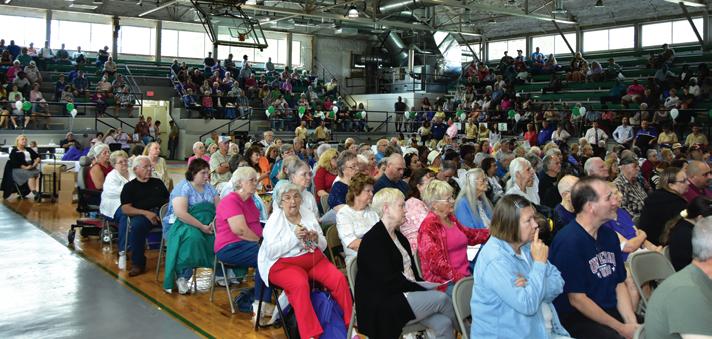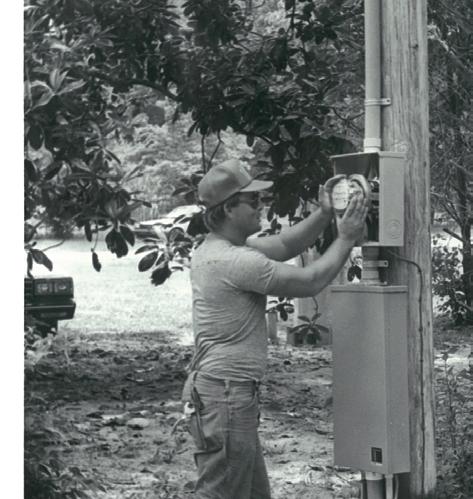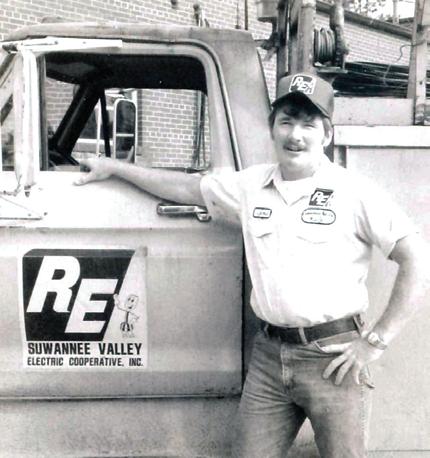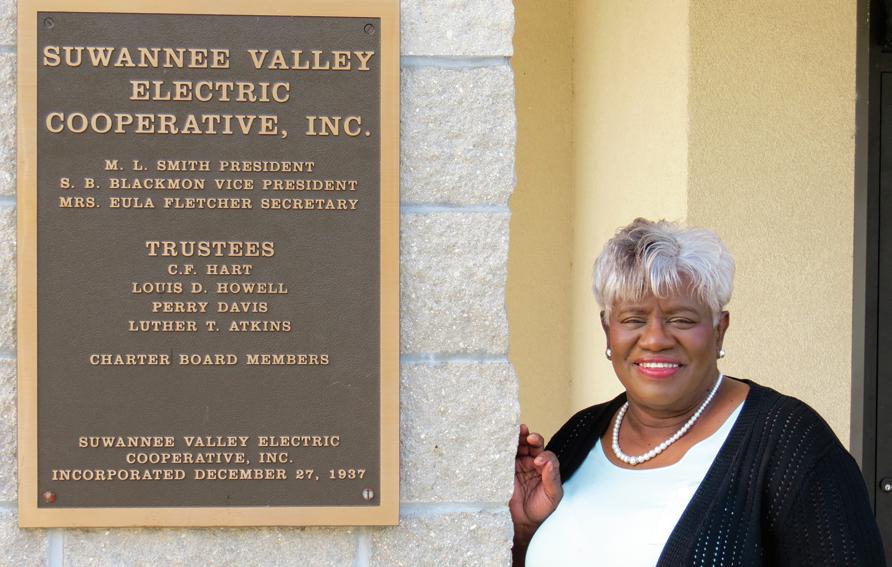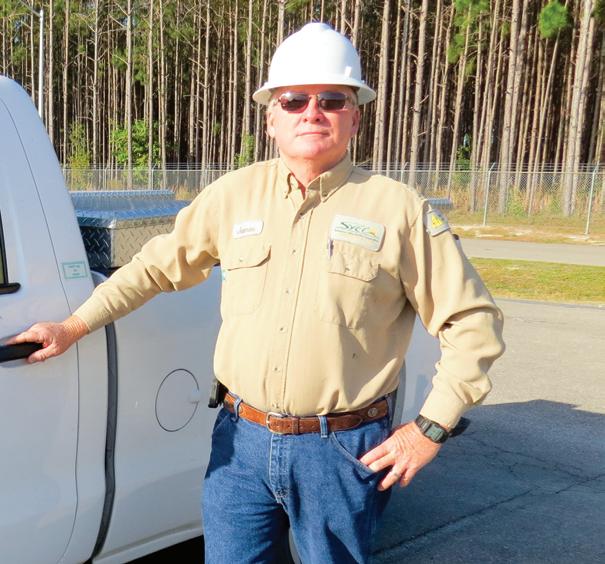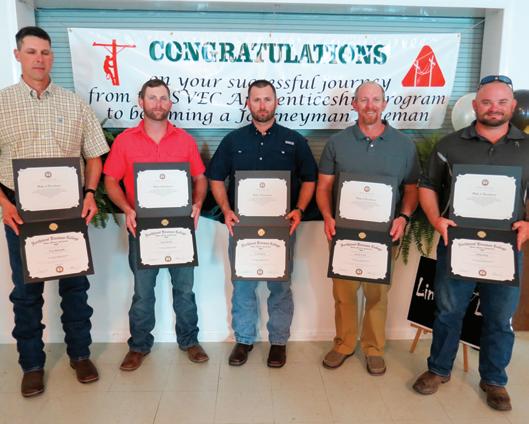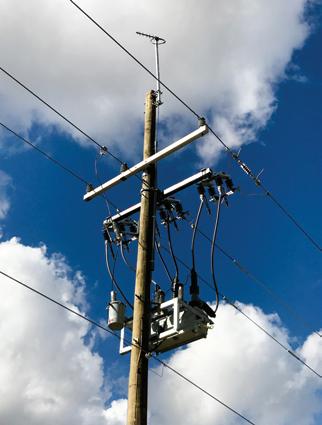SVEC celebrates 80th year at annual meeting
of serving our members
Michael S. McWaters Executive V.P./CEO
The story of SVEC is the story of rural electrification. Cooperatives like ours took on the task that forprofit companies wouldn’t think of: bringing life-changing electric service to the rural areas of this nation.
SVEC’s story goes back to 1937, when a group of Suwannee Valley residents decided to take matters into their own hands, and it’s a heritage we’re proud to continue 80 years later.
Many of you heard Hugh Hunter, our board of trustees president, recount that story at last month’s annual meeting. For those of you who couldn’t attend, you can read about the meeting and some of SVEC’s accomplishments over the last year in this newsletter.
In short, your cooperative is in very good shape. We stand on sound financial footing and achieved much across the board last year when it comes to safety, reliability and affordability.
You can also read about SVEC’s rich past as remembered by a few of the cooperative’s longest-serving employees. All three have been with us for nearly 40 years or longer and have seen incredible changes in their time.
We hope you’ll enjoy seeing the cooperative through their eyes and join us in thanking them for their decades of good work. They have spent their lives serving our members.
That service is at the heart of everything we do, and it’s what makes our job rewarding on a daily basis. Thank you for that privilege and for your continued support.
SVEC held its 80th annual meeting on Saturday, April 22 at the Suwannee County Agricultural Coliseum in Live Oak. The cooperative welcomed a crowd of nearly 700 people, including members, their families and guests.
Attendees enjoyed bingo and other contests, during which SVEC gave out nearly 200 prizes, and also had a chance to hear SVEC Board of Trustees President Hugh Hunter speak about the cooperative’s origins.
“In the 1930s, for-profit utilities wouldn’t string electric lines across woods and fields. There wasn’t any money in it,” he said. “So, the rural people of the U.S. formed their own electric utilities to serve themselves. That was the birth of Suwannee Valley Electric Cooperative.”
Hunter also updated members on the cooperative’s financial standing, which continues to be strong. The board authorized a return of around $850,000 in capital credits to members this year, meaning SVEC has returned approximately $12.7 million in capital credits since it was founded in 1937.
CEO Michael McWaters shared some of SVEC’s accomplishments over the last year, with a particular focus on safety, reliability and affordability. He noted that, as of the meeting, the cooperative had gone 920 consecutive days without a lost-time injury while
maintaining a 99.95 percent reliability rating. SVEC has also decreased the cost of electricity it provides compared to last year.
The crowd also heard from Lisa Johnson, CEO and general manager of Seminole Electric Cooperative, SVEC’s wholesale power provider. Johnson took the opportunity to thank members for making their voices heard on the issue of the Clean Power Plan and commended their enthusiasm for the new Cooperative Solar program.
“Through all of you, our members asked for access to the future of energy, and Cooperative Solar will play a part in that,” she said.
“It demonstrates Seminole’s commitment to our members, our care for the environment, and our plan for the future of energy. I understand that all of Suwannee Valley’s blocks of solar energy have already been reserved!”
In addition, three cooperative trustees were re-elected at the meeting. Mike Adams was re-elected to represent District 1, as was Jerry Goff in District 2 and Sam Roberson in District 3.
For more information on your cooperative’s annual finances, check the March 2017 newsletter. If you don’t have a copy and would like one, please call 800-447-4509 or email memberservicerep@svec-coop.com.
read
Black started his SVEC career on the right-of-way crew.
Goodman remembers recording meter readings without computers.
Changing with the times
SVEC employees reflect on the cooperative’s growth in recent decades
Since it was first incorporated in 1937, Suwannee Valley Electric Cooperative has served the people of Columbia, Hamilton, Lafayette and Suwannee counties with safe, affordable and reliable electricity.
In that time, the cooperative has seen tremendous growth and development. We spoke to some of SVEC’s longest-serving employees to learn what those changes were like.
ANDY LAWRENCESTARTED JUNE 10, 1977
When Lawrence first joined SVEC, one of his favorite parts of the job was something linemen rarely do anymore: climbing.
“I enjoyed climbing poles. I was just 18 years old, and it was fun,” he says. “I bought my own climbing tools. It took me about three weeks to learn that trade, but the guys on the crew took their time and taught
me everything I needed to know.”
Receiving the bulk of training on the job wasn’t uncommon at the time. In fact, Lawrence was thrust onto the line crew on his very first day. And while those early days were certainly formative, he makes no bones of the fact that SVEC has progressed tremendously when it comes to training and technology.
“SVEC is one of the oldest cooperatives in the state, and when I first
Andy Lawrence doesn’t get to climb poles anymore, but he still enjoys overseeing a team of 45 linemen and supervisors.
arrived it felt like it,” he says. “But we’re a very modern cooperative now. We maintain our system better, do more maintenance. We’re just far advanced beyond when I started.”
In his nearly 40 years at SVEC, Lawrence has done a little bit of everything, which has allowed him to see the impact those improvements have made across the cooperative. He worked as a lineman for 15 years, spent time in dispatch, and worked as a supervisor in the service department before taking his current position as director of operations in 2008.
As the cooperative has implemented new technologies — like the supervisory control and data acquisition (SCADA) system — and improved dispatch communications and automatic meter reading, Lawrence has more time to focus on the heart of his job: serving SVEC members.
“They depend on us to keep their lights on, build new lines and act quickly when the power goes out,” he says. “That’s a responsibility I take very seriously, and I enjoy making a difference in that way. I can’t think of anything I’d rather do than this.”
Lawrence
meters, worked lines and ran dispatch in his first 30 years at SVEC.
JANICE GOODMANSTARTED SEPTEMBER 7, 1972
Most member service representatives would have a hard time imagining their jobs without the help of computers, but not Janice Goodman. The early days of her SVEC career were filled with the clacking of Burroughs adding machines.
“That’s where we keyed in all our payments and posted all our readings,” she says. “Back then, members would look at the meters themselves and send in their readings. Then we would use the adding machines to post it to their account.”
Today’s member services department is a far cry from those days. When a member calls with a question or problem, representatives can quickly pull up all of their account information to better serve them. In addition, tools like SmartHub let members schedule payments and manage their accounts themselves, leaving member services to help them use those tools if they have a problem.
Those advancements didn’t always come easy, though. Goodman still remembers the grueling process of converting all of the cooperative’s paper documents into digital records.
“We had years’ worth of ledgers that we would pull out every day to post payments and the readings members called in to give us,” she says. “We had to transfer all of that
information to the computers by hand in order to set up those new digital accounts.”
In the end, it’s the relationships that she has been able to forge with both her co-workers and members that have brought her the most joy.
“I enjoy the people I work with and enjoy having the chance to meet and talk to members,” she says. “Some of them I’ve gotten to know personally. After all these years, some people still call and ask for me. That feels good.”
JAMES BLACKSTARTED MARCH 5, 1973
Like his co-workers, James Black, service supervisor at SVEC, has seen the ways technology has saved time and made jobs safer.
But from his vantage point as service supervisor, he can also see how it helps the cooperative run more effectively.
Black started on the right-of-way crew when most of the job was done by hand, using chain saws and bush hooks. These days, with tractors and additional bucket trucks, clearing right-of-way is not only easier but also more efficient.
“You can take two men now and accomplish more work than five or six of us could when I was on rightof-way,” he says.
The same is true in other areas of the cooperative, like mapping and dispatch. Before the installation of the SCADA system, which allows
Goodman has seen many changes since 1972, but her favorite part of the job is still talking with members.
the cooperative to automatically pinpoint problems on the electrical grid, running dispatch during a major storm could be a 10-person job.
“Someone had to answer the phone, get the member’s name, manually look up their location in a book, and then dispatch the crew to it,” Black says. “If you had 100 calls in a night, you needed several phone lines open and people to answer each one, plus a few people to sort the calls to determine if it was a single outage or if a whole section of line was out.”
These days, all of that can be done with just a couple of employees, leaving the rest to focus on solving the problem and strengthening the system. That’s the aspect of the job that Black enjoys more than anything else.
“It’s a bit like law enforcement or the fire department in that it’s more of a service than it is a job,” he says. “Climbing a pole or going up in a bucket to work with high-voltage electricity isn’t something everyone would choose to do for their neighbor, and I take pride in doing that.”
In particular, the big storms are the ones that stand out in Black’s mind. The greater the challenge is, the greater the feeling of camaraderie and accomplishment among his co-workers.
“It seems like when we have a major storm, everybody pulls together for that one purpose,” he says. “And though I don’t like to see them come, I like to beat them.”
Lawrence agrees, adding that the sense of service is never greater than when everyone at SVEC works together to overcome a challenge and get the power back on.
“We see it as we practice all year for the big one,” he says. “You have the outside crew dealing with the elements and the office staff working to support them. It’s a good feeling when everyone coordinates and things come together. And we do it all for the members.”
After 44 years,
Black still enjoys the challenge of a big outage.






